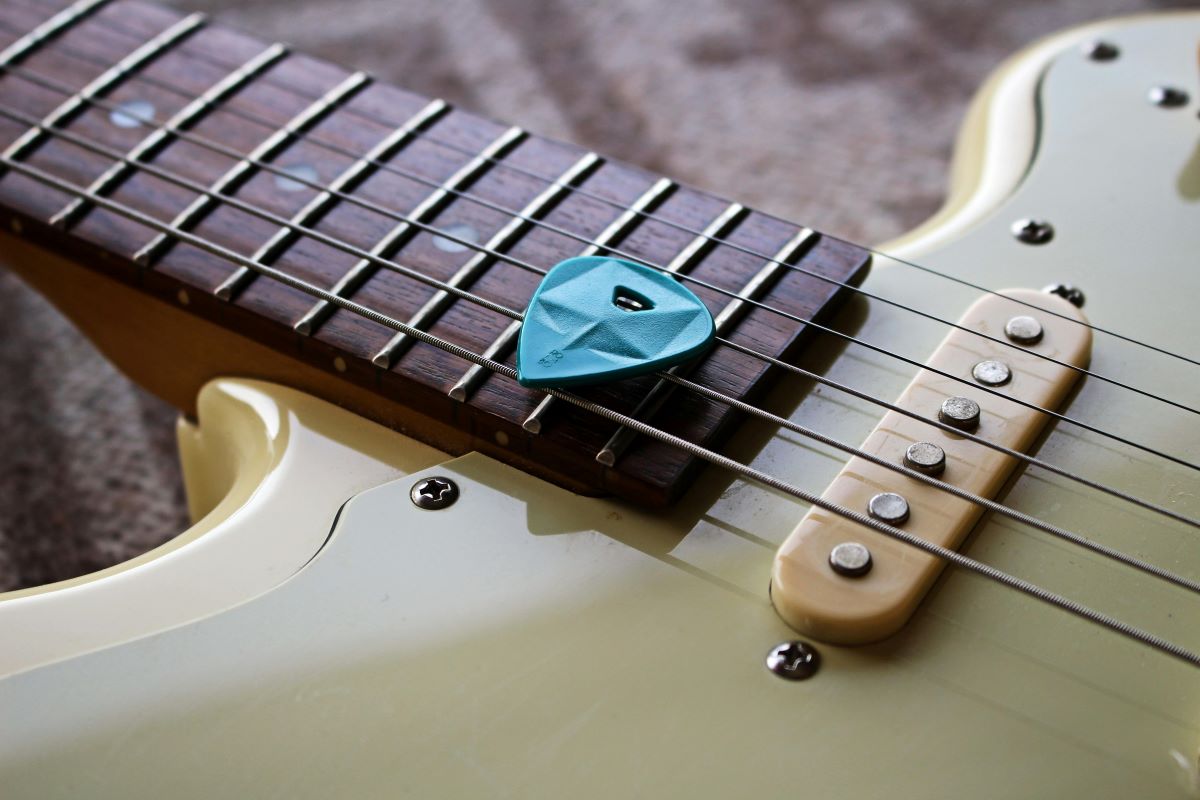Getting your guitar professionally set up is usually not at the top of most guitarists' To Do List. But it should be. A well setup guitar will not only be a pleasure to play but will also sound better.
Regardless of what level you’re playing at, how expensive your guitar is, and especially if you’re new to the instrument, you need to get your guitar set up by a professional. It could well change it from “It’s ok to play” to “Wow, I love playing my guitar!”.
But what’s included in a pro guitar setup? And how often does it need to be done? Let’s find out, but before that…
Why are so many guitars badly set up?
Most of the guitars I pick up and play are not set up properly. They could belong to a pupil or a friend, or be in a music store. Either way, there are usually very simple improvements that could be made to them.
This could be due to financial reasons because professional setups aren’t cheap. But I think the main problem is that there is so much preached on the internet about how easy it is to set up a guitar yourself.
To be perfectly honest, the fundamentals of correctly setting a guitar up are relatively basic. But so are the fundamentals of servicing a car. But I would estimate that 99.9% of car owners take it to a garage to get the job done properly by qualified mechanics who have mastered the art.
So why not do the same with your guitar? Why is it that so many guitarists think that their attempt at setting up a guitar will produce a result anywhere near that of a professional luthier who sets guitars up every working day?
In the majority of cases, it won’t be. I’m not saying that you shouldn’t make small tweaks to your instrument when it needs it. That’s fine. But most guitarists will not be able to set a guitar up as well as a professional. So, I highly recommend that you use one.
Now that very important point has been covered, let’s take a look at…
Professional Guitar Set Up - What’s Involved?
A pro guitar setup involves the luthier adjusting various parts of the instrument as well as performing routine maintenance tasks that will optimize a guitar’s playability, sound, and condition.
After completion, the guitar should be incredibly comfortable to play, sound great, and be in optimum working order.
However, lots of guitarists don’t seem to realize that one adjustment often affects another; this is especially the case with complex bridge setups. Therefore, the skill of the luthier is to adjust all the parts to achieve the combined optimum.

What’s included in a setup will depend on the type of guitar. For example, there will be no need to check the pickups, switches, etc., when working on most acoustic guitars.
A Typical Electric Guitar Setup consists of:
Truss Rod Adjustment
The truss rod is a metal rod that is inserted into the neck of most guitars when they are manufactured.
It is usually adjusted by inserting the correct size Allen key or a dedicated luthier's tool into a slot which is usually found at the bottom of the face of the headstock or underneath a truss rod cover located in the same place.

On acoustic guitars, the slot is usually found at the base of the neck and accessed through the soundhole.
Adjusting the rod either clockwise or anti-clockwise optimizes the curvature of the neck (relief) to prevent any fret buzz and to create the action the player has requested.
Setting the Correct Action
Along with changes to the truss rod, the height of the strings will be adjusted to the preference of the guitar's owner. This is usually achieved by raising or lowering the bridge.
Most players want the action to be very low, therefore making the guitar easier to play; however, if, for example, it will be used to play slide, it will need a higher action.
Intonation Adjustment
This involves ensuring that the guitar is in tune all over the fretboard. To achieve this, each of the saddles on the bridge is moved ever so slightly forward or backward until the notes on the twelfth fret are perfectly in tune with the open strings.
Nut Height and Slot Filing
Back to the headstock, the luthier will adjust the overall nut height by either sanding the bottom if it is too high or replacing the whole nut with a new one if it is too low.
Then, each individual nut slot will be filed to create the desired action and improve tuning stability.

Pickup Height Adjustment
Depending on the instructions of the owner, the output of each pickup will normally be balanced to create the same volume across all the strings and between the various pickups.
However, if, for example, the owner wants the bridge pickup to be a little hotter, suitable adjustments will be made.
Fretboard Cleaning and Conditioning
The luthier will thoroughly clean the fretboard, especially around the fret wires where dirt and grime are often found. Then, the fingerboard is usually conditioned with oil.
Fret Leveling and Polishing
All frets will then be checked for any damage or unevenness. The frets will then be leveled and polished.
Electronics Check
The guitar is now plugged in and played to ensure that the pots, switches, jacks, and any other electronic components are all working correctly. If issues are found, the wiring or parts will either be repaired or replaced.

Restringing
Now that the process is nearly finished, a fresh set of strings are placed on the guitar.
Final Check
Once complete, critical adjustments are checked once more to make sure that the guitar is in optimal condition.
How often should I get my Guitar Set Up?
There is a lot of debate about how often a guitar should be set up, and a lot of factors will come into play.
To start, how often do you play your guitar, and for how long? If you play for a few hours a day, five days a week, then you’ll need a pro setup a lot sooner than someone who takes it out of its case for a strum on a Sunday afternoon.
Next, how many guitars do you own? Guitar collecting is a lot more popular these days than it was 20 or 30 years ago. Therefore, even if you play nearly every day but vary the instrument, you can leave it a little longer between setups.
My recommendation for most active guitarists is to have it set up about once a year. If you gig or record a lot, then you might need to do it more often. If you’re more of an occasional player, once every 18 to 24 months should be fine.
Should I get my Guitar Setup if I change String Gauge?
In a perfect world, yes. Switching to a heavier set of strings increases the amount of tension exerted on the neck, which can have an effect on the neck relief, the action, and the intonation.

However, if it is only a minor change of gauge, or you didn’t notice any differences after the change, then you more than likely don’t need to get it set up.
Can I set up my own Guitar?
It’s your guitar, so you can do whatever you like with it. But I beg you not to do it unless you at least have some experience in setups.
On the whole, there isn’t much that can go wrong. The voltage carried by electric guitars isn’t enough to electrocute you, so no worries there. However, you do need to be careful if you don’t know what you’re doing.
Take, for example, truss rod adjustments. These should only be made in quarter turns, and you need to wait for the neck to stabilize before continuing. If you overdo it and turn the truss rod too much in a particular direction, it could either break or damage the wood around it. Both of which could mean a neck replacement.
That’s about as serious a problem as you could encounter. But, as I mentioned, there is no way that you can do the job anywhere near as well as a professional who sets guitars up every single day. So why even try?
As the old saying goes… Quality comes at a cost!
A professional luthier costs a lot, but the quality of the result is assured, so take your beloved guitar to them, and look forward to your guitar coming back to you in its absolute prime.
Wrapping it Up!
For those of you who are still sitting on the fence, wondering if a professional guitar setup is worth the money, I only have one thing to say…
Try it once, if it doesn’t blow you away, then don’t bother doing it again!
But I know from experience that it will. It’s exactly the same as when you take your car in to be serviced. When you’re driving it home, it just feels like a different car - better road-holding, more performance, more dynamic. And it’s the same for your guitar when you play it after a quality setup - it just feels, plays, and sounds better.
I know that a guitar setup from a professional luthier costs a fair amount of money. But it’s worth every penny. If you love your instrument, which I know you do, let it be the very best it can possibly be, and a setup from a pro will give you exactly that.


Share:
String Trees: How can such a Small Part have a Big Impact on Your Tone
Steve Rothery’s Squire Stratocaster - Why does one of Prog Rock's greatest guitarists play a Squire?